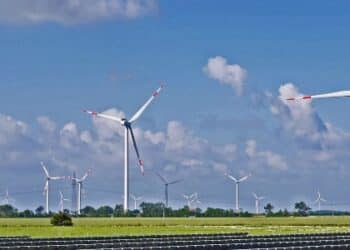Natural growth patterns are fundamental to understanding the development and complexity of biological and ecological systems. From the branching of trees to the formation of coral reefs, these patterns embody efficiency, resilience, and adaptability. Recognizing and analyzing these patterns provides insights not only into the natural world but also informs innovations in design, technology, and digital systems.
This article explores how principles of natural growth are mirrored in modern digital models, particularly in gaming mechanics like cascading reels. By examining these systems, we reveal the deep connections between biology and technology, illustrating how contemporary designs emulate nature’s timeless strategies for expansion and reproduction.
Table of Contents
- Introduction to Natural Growth Patterns and Their Significance
- Fundamental Principles of Growth: From Cells to Ecosystems
- Mimicking Nature: How Systems and Designs Replicate Growth Patterns
- Cascading Reels as a Digital Illustration of Growth Dynamics
- Case Study: Rocket Reels and the Mimicry of Growth Patterns
- The Role of Speed and Randomness in Simulating Growth
- Non-Obvious Connections: Growth Patterns in Data and Network Systems
- Implications for Design, Education, and Gaming
- Conclusion: Bridging Nature and Technology through Growth Patterns
Introduction to Natural Growth Patterns and Their Significance
Natural growth patterns are recurring structures and processes observed across living organisms and ecological systems. These include the spiral arrangement of sunflower seeds, the fractal branching of trees, and the layered formation of coral reefs. Such patterns arise from simple rules governing cellular replication, resource distribution, and environmental adaptation, leading to complex yet efficient structures.
Understanding these patterns is crucial in multiple fields. In biology, they explain developmental processes and evolutionary advantages. In ecology, they reveal how species optimize resource use and space. In design and architecture, mimicking these patterns fosters sustainable and resilient structures. Furthermore, in digital simulations, these principles guide the creation of realistic models that emulate natural phenomena, enriching visualizations and interactive experiences.
Fundamental Principles of Growth: From Cells to Ecosystems
Basic mechanisms of growth: replication, expansion, and branching
At its core, growth involves the processes of replication—where cells or units produce identical copies; expansion—where structures increase in size; and branching—where growth diverges into multiple directions. These mechanisms operate across scales, from microscopic cellular division to large-scale ecological colonization.
Examples of natural growth: plant tendrils, fungal mycelium, coral structures
- Plant tendrils extend and curl to seek support, demonstrating adaptive branching
- Fungal mycelium spreads through hyphal networks, optimizing nutrient absorption
- Coral colonies grow in intricate, fractal-like patterns, maximizing surface area
Common features such as symmetry, fractal geometry, and adaptive expansion
Many natural growth forms exhibit symmetry—bilateral or radial—enhancing stability. Fractal geometry explains the self-similar branching seen in trees and veins, allowing efficient space-filling. Adaptive expansion enables organisms to respond dynamically to environmental constraints, exemplifying resilience and resource optimization.
Mimicking Nature: How Systems and Designs Replicate Growth Patterns
The role of algorithms and computational models in simulating growth
Modern computational models employ algorithms inspired by natural rules—such as L-systems, fractal algorithms, and agent-based simulations—to replicate growth. These models generate complex structures from simple instructions, accurately reflecting natural branching and expansion behaviors. Such simulations are widely used in virtual environments, architectural planning, and artistic expressions.
Case studies of natural-inspired designs in architecture, art, and technology
- The Eden Project in the UK, featuring geodesic domes inspired by geometric growth patterns
- Fractal art installations that mimic natural branching and fractal forms
- Biomimetic robots designed with limb structures resembling insect or plant appendages
The significance of visual and functional resemblance to natural growth
Replicating natural forms enhances aesthetic appeal and functional efficiency. For example, structures inspired by leaf venation can optimize light capture, while fractal patterns improve signal distribution in antennas. This synergy of form and function underscores the importance of understanding natural growth principles for innovative design.
Cascading Reels as a Digital Illustration of Growth Dynamics
Explanation of cascading reels and their mechanics in gaming contexts
Cascading reels are a popular mechanic in modern slot games where winning symbols are replaced by new symbols that fall from above, creating chain reactions. This process continues until no new wins occur, mimicking natural growth by simulating continuous propagation and expansion within a confined space.
How cascading reel systems emulate natural processes like branching and propagation
These systems visually resemble biological phenomena such as branching pathways or colony expansion. Each cascade resembles a wave of growth, propagating through the system, much like how fungal networks spread or how tree branches bifurcate. The repetitive, self-similar nature of cascading effects echoes fractal growth patterns observed in nature.
The concept of cluster wins and their similarity to colony growth or cellular reproduction
Cluster wins occur when multiple symbols align in connected groups, emphasizing collective growth. This mirrors biological clustering phenomena like cellular colonies or the formation of coral reefs, where individual units work together, expanding and reinforcing the structure as a whole.
Case Study: Rocket Reels and the Mimicry of Growth Patterns
Introduction to Rocket Reels’ cascading reel features
Rocket Reels exemplifies how digital slot mechanics can mirror natural growth, with symbols cascading downward and new symbols launching into view. This dynamic creates a visual narrative of upward expansion and energetic propagation, aligning with natural growth themes.
How the appearance and launch of rocket symbols resemble vertical growth or upward expansion
The launch of rocket symbols mimics vertical growth, akin to plant shoots or cellular proliferation. Their ascent symbolizes upward expansion, emphasizing progress and dynamic development. This visual metaphor reinforces the idea of growth as an active, energetic process.
The dynamic of cluster formation and how it reflects natural clustering phenomena
Clusters of matching symbols form and expand through cascading effects, echoing how natural colonies or fungal networks grow through interconnected units. The formation and merging of these clusters demonstrate collective growth, resilience, and adaptive expansion, illustrating core biological principles within a digital environment.
For those interested in seeing such innovative design influenced by natural principles, explore that Rocket Reels slot offers a compelling example of how modern gaming mechanics incorporate these timeless ideas.
The Role of Speed and Randomness in Simulating Growth
Impact of turbo play on the perception of growth and expansion
Turbo modes accelerate the cascading process, intensifying the perception of rapid growth and expansion. This mirrors natural phenomena like rapid fungal colonization after environmental triggers or swift cellular reproduction during healing, emphasizing the dynamic aspect of growth.
Random symbol appearances as analogs to unpredictable natural events
- Spontaneous mutations or environmental disturbances that influence biological growth
- Random dispersal of spores or seeds leading to colonization
- Unpredictable resource availability affecting expansion rates
How these elements enhance the realism and engagement of growth models in gaming
Incorporating speed and randomness introduces variability, making the simulation less deterministic and more lifelike. This unpredictability captures the essence of natural growth, fostering deeper engagement and a sense of organic development within digital environments.
Non-Obvious Connections: Growth Patterns in Data and Network Systems
Parallel between biological growth and data network expansion
Digital networks, like biological systems, expand through nodes and connections, forming complex, adaptive structures. Viral spread on social media mimics colony growth, where information propagates through interconnected users, resembling cellular reproduction or fungal networks.
Cascading effects in network systems, viral spread, and information propagation
Cascading effects—where one event triggers a series of subsequent reactions—are central to understanding phenomena like viral content or cascading failures in infrastructure. These dynamics reflect how natural systems propagate growth through interconnected units, emphasizing the importance of robustness and adaptability in both biological and digital realms.
Lessons from natural growth for optimizing digital systems and algorithms
By studying natural growth, engineers and data scientists develop algorithms that optimize network resilience, load balancing, and information flow. Fractal and branching models improve the efficiency of data routing and resource allocation, demonstrating the practical value of understanding natural growth principles.
Implications for Design, Education, and Gaming
How understanding natural growth enhances game design and user experience
Incorporating growth-inspired mechanics creates more engaging and intuitive gaming experiences. Players resonate with visuals that mirror natural processes, fostering a sense of familiarity and organic progression. This approach also facilitates learning complex systems through interactive and visual means.
Educational value: teaching complex systems through visual and interactive models
- Using simulations of growth patterns to demonstrate biological and ecological principles
- Interactive models that visualize fractal geometry and branching processes
- Enhancing STEM education through engaging visualizations rooted in natural principles
Future prospects: leveraging growth patterns for innovation in technology and entertainment
Advances in computational modeling and biomimicry open new frontiers for sustainable architecture, adaptive algorithms, and immersive entertainment. Emulating natural growth offers pathways to resilient designs, efficient resource management, and richer user experiences, fostering a continuous dialogue between science and innovation.
Conclusion: Bridging Nature and Technology through Growth Patterns
Natural growth principles—characterized by replication, branching, and adaptive expansion—inspire a wide array of digital and physical designs. Systems like cascading reels serve as modern illustrations of these timeless patterns, demonstrating the profound influence of nature’s strategies on contemporary technology.
“Understanding and mimicking natural growth not only enhances aesthetic and functional design but also paves the way for innovative solutions across disciplines.”
As technology continues to evolve, the ongoing dialogue between natural science and digital innovation promises exciting developments. By studying growth patterns—whether in ecosystems or algorithms—we unlock new potentials for sustainability, resilience, and creativity in our increasingly complex world.








